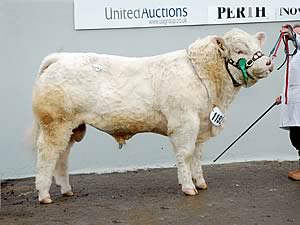21/01/08
The British Charolais Cattle Society has introduced a Terminal
Index (TI) and a Self Replacing Index (SRI), two new major Indexes
to its Breedplan registration and genetic evaluation system.
 |
Each Index is reported as an Estimated Breeding Value (EBV), in
units of relative earning capacity per cow mated for the given
market, and reflects the potential profit generated by a sire for
the production system.
The BCCS Terminal Index (TI) is a multi-trait index primarily designed
for commercial producers. It ranks bulls by their genetic potential
to produce Charolais crosses taken to target weight within 18 months.
TI takes in Estimated Breeding Values (EBVs) of recorded cattle
for a range of traits split into three distinct sections: growth,
conformation and calving ease direct.
The BCCS Self Replacing Index (SRI) is a multi-trait index primarily
to help both pedigree and commercial producers breeding heifer
replacements. SRI places emphasis on calving ease, gestation length
and days between calves, together with production and conformation
traits. In addition, SRI reflects the potential performance of
pure Charolais steer performance finished to target weight within
16 months.
“These two new multi-trait Indexes will enable primary producers
to identify bulls that will make a significant contribution towards
maximising the number of weaned calves per year, their performance
potential and subsequently the herd’s returns,” explains
the society’s chairman Steven Nesbitt. “They should
be used along with the index component EBVs to enable farmers to
take full advantage of the Charolais breed’s accelerated
genetic progress in their selection making decisions.
“Both indexes were compiled for UK conditions taking into
account not only the recorded cattle data, but various production
and financial parameters. Benefits and costs evaluated include
those for the sale animal from birth to slaughter, and average
running costs for a commercial herd – both variable and fixed
costs, including family and paid labour. The latter is an element
we believe to be particularly important at a time when cost structures
are forcing more and more units to adopt extensive management strategies,” he
says.
Mr Nesbitt adds: “For suckler producers using TI, then there’s
no longer any reason why they shouldn’t buy a bull that will
leave the highest performing progeny that are also easy to calve.
On the other hand, SRI will enable both our breeders and commercial
producers to identify bulls that will leave the most efficient
beef producing heifer replacements.”
TI and SRI indexes will
be updated on a regular basis by Breedplan’s
manager, the Agricultural Business Research Institute (ABRI). The
indexes accompany each recorded animal in the British Charolais
Herdbook and can be viewed on line; they will also be made available
in pedigree catalogues and displayed at official society sales.
Charolais EBVs and indexes are specific to Charolais cattle, and
are not comparable across other beef breeds.
 Solid
Trade for Carlisle Charolais Solid
Trade for Carlisle Charolais
 Poor Cattle Prices are History says NBA Poor Cattle Prices are History says NBA
 The Outlook for Red Meat - Outlook 2008 The Outlook for Red Meat - Outlook 2008
 Beef Production on the Rise in China Beef Production on the Rise in China |




